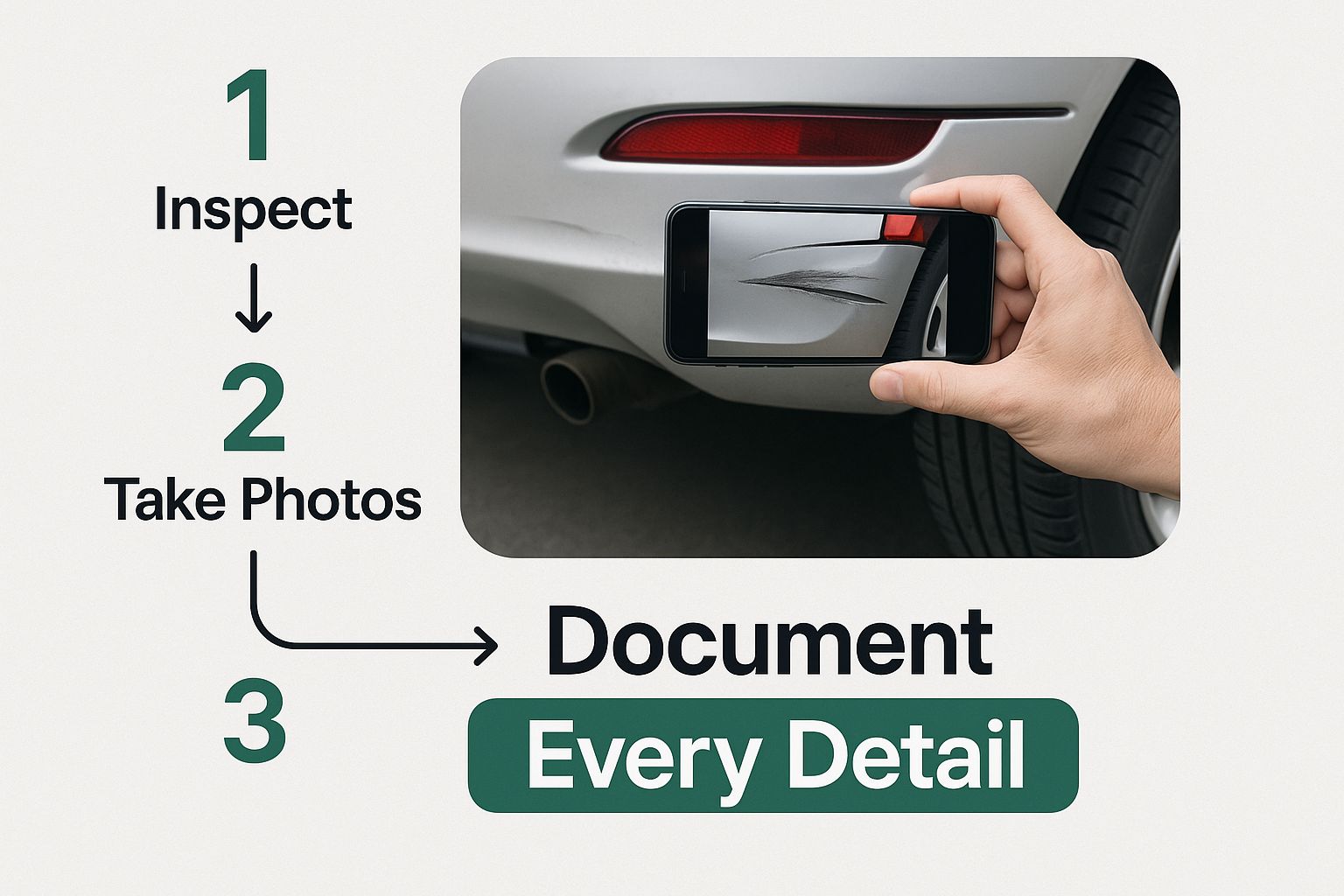How to negotiate with insurance companies for fair payouts starts with understanding that the first offer is just a starting point. It’s their opening bid in a negotiation you probably didn’t even know you were in. Their initial number is often intentionally low, and your job is to push back with credible evidence to secure the fair settlement you’re actually owed.
Why You Must Negotiate Your Insurance Settlement
Insurance companies aren’t in the business of paying out more than they have to. Their adjusters are trained negotiators whose main objective is to settle claims for as little as possible. That’s why their first offer is almost never their best—it’s a calculated move to see if you’ll simply take the money and go away.

Many vehicle owners make the mistake of assuming this initial figure is final. Accepting it can mean leaving hundreds, or even thousands, of dollars behind. This is especially true when dealing with a total loss or a significant diminished value claim, which is the loss in your car’s resale value after an accident. Insurers often lean on their own software, which might use outdated data or irrelevant comps to undervalue your car’s true fair market value.
The Power Imbalance in Negotiations
Let’s be honest—there’s a huge experience gap in How to Negotiate with Insurance Companies. Insurance companies process thousands of claims a day, while you might only deal with one in your lifetime. They know the playbook, the legal fine print, and exactly where to apply pressure to get people to accept a lowball offer.
You’re at a serious disadvantage unless you come prepared. This is where solid documentation becomes your best friend and helps level the playing field.
Here’s what you need to shift the power back in your favor:
- Independent Repair Estimates: Get a few quotes from body shops you trust. This provides a real-world baseline for repair costs, not just the insurer’s preferred number.
- Comparable Vehicle Listings: Do your own homework. Find vehicles similar to yours for sale in your local area to establish what your car was actually worth moments before the crash.
- A Certified Appraisal Report: This is your ace in the hole. An unbiased, data-backed report from a professional appraiser provides irrefutable proof of your vehicle’s value, strengthening your claim.
A well-documented claim changes the entire conversation. It’s no longer your opinion versus theirs; it’s your facts versus their low offer. Your goal is to make their number impossible to defend.
By approaching this like a business deal, you can advocate for yourself with confidence. And while we’re focused on vehicle damage here, it’s worth understanding the bigger picture. Learning how they handle personal injury claims can give you even more insight into their tactics—check out our guide on how to maximize your personal injury case settlements.
At the end of the day, remember you have every right to question their numbers and present your own evidence. It’s your claim and your money.
Building Your Case Before You Call the Adjuster
If you want to negotiate successfully with an insurance company, you have to think like a professional. A good negotiation is often won long before you ever pick up the phone. It’s all about building an undeniable case, piece by piece, so when you finally speak to the adjuster, you’re leading the conversation with facts, not just feelings.
Your first move? Become a meticulous record-keeper. Every single piece of paper, every email, and every photo helps tell the story of your claim and strengthens your position.
Gather Your Essential Documents
Start by pulling together all the official paperwork related to the accident. This isn’t just busywork—it’s the foundation of your entire claim. Being organized tells the insurer you’re serious and methodical.
Here’s what your evidence checklist should include:
- The Official Police Report: This is your objective, third-party account of what happened. It’s absolutely crucial for establishing who was at fault.
- Repair Estimates: Get at least two detailed estimates from body shops you trust, not just the ones the insurance company suggests. This gives you a realistic baseline for what the repairs should cost.
- Medical Records (if applicable): If you were injured, keep a running file of every doctor’s visit, treatment, and bill.
The image below highlights the most important first step you can take at the scene of the accident to start building your case.

This really drives home the point: immediately documenting the damage with clear, comprehensive photos from every angle is non-negotiable.
The Cornerstone of Your Claim: An Independent Appraisal
While police reports and repair quotes are essential, the single most powerful tool in your arsenal is an independent, certified appraisal. This is the document that completely shifts the dynamic of the negotiation.
An insurer’s valuation comes from their own internal software, which is designed to save them money. A SnapClaim certified appraisal, on the other hand, gives you an unbiased, data-driven valuation of what your vehicle is actually worth in the real world.
Armed with a professional appraisal, you transform the conversation. Instead of debating their lowball number, you can simply ask them to justify why their valuation doesn’t match up with verifiable market data.
This strategy is backed by professional negotiation tactics. Parties who walk in with data-driven arguments, maintain a professional tone, and document everything are far more likely to get the outcome they want.
Whether you’re dealing with a total loss or filing for diminished value, this report is your proof. If this is your first time navigating this process, our guide on how to file a diminished value claim is a great place to start.
And remember, investing in a SnapClaim report is a risk-free move. Our money-back guarantee ensures that if the insurance recovery from the claim is less than $1,000, the appraisal fee is fully refunded. This lets you build the strongest case possible with complete confidence.
Communicating Effectively With the Insurance Adjuster
How you talk to the insurance adjuster can make or break your settlement. Every single conversation is a negotiation. Your job is to stay professional, stand firm, and stick to the facts. Emotional pleas won’t get you anywhere, but a calm, organized approach backed by solid proof will.

Think about it from their perspective: adjusters are juggling dozens of claims a day. They are trained to control the conversation and settle for the absolute lowest amount possible. Your mission is to show them—right from that first phone call—that you’re prepared, serious, and not going to be pushed around.
Set the Right Tone From the Start
The moment that first call begins, you need to establish a professional boundary. Be polite, of course, but skip the friendly small talk. Don’t volunteer extra details about your day or your life. The conversation should stay laser-focused on the facts of your claim and the evidence you’ve gathered.
Never, ever admit fault, even a little bit. A simple “I’m sorry it happened” can be twisted and used against you later. It’s also a bad idea to guess about details you aren’t sure of, like speed or timing. If you don’t know an answer, it’s completely fine to say, “I don’t recall right now” or “Let me check my notes and get back to you on that.”
Create a Bulletproof Paper Trail
Documentation is your absolute best friend in this process. Phone calls are quick, but they leave no official record of what was said. You need to protect yourself by creating a paper trail for every single interaction.
- Follow Up Every Call: After you hang up the phone, immediately send a short, polite email to the adjuster. Summarize what you discussed, any agreements you made, and what the next steps are. This creates a written record they can’t deny later.
- Use Email Whenever Possible: For any important discussion, default to email instead of the phone. This gives you a clean, timestamped log of all your communication.
- Keep a Detailed Log: Get a notebook or start a digital file. Log the date, time, and a quick summary of every conversation. Make sure to note the adjuster’s name and ID number, too.
The goal here is to build a documented history that proves you are organized and paying close attention. This kind of preparation signals to the adjuster that you aren’t an easy target for a lowball offer.
Presenting Your Independent Appraisal
This is the moment of truth. When the adjuster comes back with their predictably low initial offer, your response shouldn’t be anger—it should be facts. This is where you confidently bring out your independent appraisal report.
Don’t just say, “That’s too low.” Instead, try a script like this:
“Thank you for that initial figure. My own research, supported by a certified appraisal from an independent expert, shows my vehicle’s actual fair market value is $X. My report is based on current, local market data for comparable vehicles. Could you please send over the specific comps and the methodology you used to arrive at your lower valuation?”
This approach does two crucial things: it frames your SnapClaim appraisal as the more accurate, data-backed number, and it shifts the burden of proof back to them. You’re no longer arguing about opinions; you’re challenging their flimsy evidence with superior facts. It’s a critical part of learning how to negotiate with insurance companies and win.
Remember, this whole process is a marathon, not a sprint. Patience and persistence, when combined with rock-solid documentation, are your most powerful weapons for getting the fair settlement you actually deserve.
How to Craft a Compelling Counteroffer
Getting a lowball settlement offer from an insurer can be frustrating, but don’t get discouraged. Honestly, it’s a standard opening move in the negotiation game.
Your job is to fire back with a counteroffer that’s so well-supported, they can’t ignore it. This isn’t about pulling a random number out of thin air. It’s about presenting a specific, justifiable figure backed by every shred of evidence you’ve collected.
Structuring Your Demand Letter
The best way to present your counteroffer is with a formal demand letter. Think of it as a professional, written document that lays out your entire case. It systematically picks apart the insurer’s low offer while building an airtight argument for your own valuation.
A well-written letter immediately signals that you’re organized, serious, and not going to be pushed around.
Make sure your letter includes these key things:
- Your Exact Number: Start by clearly stating the dollar amount you’re asking for. This figure should come directly from your SnapClaim certified appraisal report.
- Your Pile of Proof: Reference all the documents you have—the appraisal, police report, repair estimates, and listings of comparable vehicles you found. Attach copies of everything.
- A Point-by-Point Rebuttal: Calmly and factually explain why their initial offer is just plain wrong. Point out the specific flaws in their report, like using comps from another state or cars that aren’t even the same trim level.
This letter officially puts the ball back in their court. Now, they have to respond to your data, not just stick to their own flawed assessment.
Dismantling Their Lowball Offer With Facts
Your SnapClaim appraisal is your secret weapon here. It transforms the conversation from opinion to fact.
Instead of just saying, “Your offer is too low,” you can hit them with something they can’t argue with: “Your offer of $15,000 is 18% below fair market value. My certified appraisal, based on five local comparable vehicles sold in the last 30 days, proves the actual value is $18,300.”
A fact-based approach forces the adjuster to justify their number with equally strong evidence—which, spoiler alert, they almost never have. You’re no longer just another claimant; you’re a prepared negotiator armed with undeniable proof.
This is a fundamental part of learning how to negotiate with insurance companies. The goal is to make it logically impossible for them to stick to their initial number without looking completely unreasonable. For a deeper look at this strategy, check out our guide on what to do if you get an unfair insurance offer for a totaled vehicle.
Confidence Backed by a Guarantee
We get it. Going head-to-head with a massive insurance corporation can feel intimidating. That’s why we’ve made this process completely risk-free for you.
SnapClaim’s money-back guarantee is straightforward: if the insurance recovery from the claim is less than $1,000, the appraisal fee is fully refunded.
This guarantee means you can build your counteroffer with the strongest possible evidence without any financial risk. You have absolutely nothing to lose and a much, much fairer settlement to gain.
What to Do When the Insurer Won’t Cooperate
Sometimes, even with an airtight case and a solid counteroffer, the insurance company just digs in its heels. You’ll run into adjusters who stick to a lowball number, ignore your evidence, or drag their feet, hoping you’ll get frustrated and give up.
When you hit this wall, it’s not the end of the road. It just means it’s time to escalate.
Your first move is simple but surprisingly effective: ask to speak with a supervisor or manager. A fresh set of eyes can break a stalemate, especially if the adjuster you’re dealing with is inexperienced or just doesn’t want to reconsider their initial assessment. A supervisor almost always has more authority to approve a higher settlement anyway.
Invoking the Appraisal Clause
If a manager doesn’t move the needle, your auto insurance policy has a powerful tool that most people don’t even know exists: the appraisal clause. This clause is specifically designed to settle disputes over your vehicle’s value without the headache and expense of going to court.
Here’s how it works in a nutshell:
- You hire an independent, competent appraiser (like us here at SnapClaim).
- The insurance company hires its own appraiser.
- These two appraisers then agree on a neutral third-party expert, known as an umpire.
A settlement value agreed upon by any two of the three parties becomes binding.
This process pulls the decision out of the adjuster’s hands and gives it to impartial experts—a huge advantage when negotiations have completely stalled.
Filing a State Insurance Complaint
Another crucial step is filing a formal complaint with your state’s Department of Insurance. This is the government body that regulates insurers and makes sure they’re treating policyholders fairly.
The screenshot below from USA.gov shows where you can find your state’s specific commissioner.
This directory is your starting point for holding your insurer accountable for unfair claim handling or bad faith practices. While the department won’t force a specific payout, an official complaint definitely gets an insurer’s attention and can trigger a senior-level review of your claim.
When to Consult an Attorney
Finally, if your claim involves serious injuries, a complicated liability dispute, or clear signs of bad faith from the insurer, it’s time to bring in a lawyer.
Knowing when to hire an attorney for a diminished value claim can be the turning point that forces a fair resolution. An attorney brings leverage to the table that a consumer just doesn’t have. It’s a dynamic seen across the insurance world; think about how a large group’s bargaining power impacts health insurance negotiations. As decent.com explains, there’s strength in numbers and professional representation.
An attorney brings that same kind of muscle to your individual claim.
FAQ: Negotiating with Insurance Companies
How do I start a negotiation with an insurance adjuster?
The best way to start is by being prepared. Before you even speak with the adjuster, gather all your evidence: the police report, repair estimates, and most importantly, an independent appraisal report. When they present their initial offer, don’t argue emotionally. Instead, calmly state that your research shows a different value and ask them to provide the specific data they used to justify their lower number. This puts you in control of the conversation.
What should I not say to an insurance adjuster?
Never admit any fault, even partially. Avoid saying things like “I’m sorry” or “I wasn’t paying full attention.” Also, do not speculate or guess about facts you’re unsure of, such as speed or exact times. Stick only to what you know for certain. It’s also wise to avoid giving a recorded statement until you have all your documentation in order and feel fully prepared.
Is it worth it to negotiate with an insurance company?
Absolutely. The insurer’s first offer is almost always a low starting point, not their final offer. By preparing a well-documented counteroffer, vehicle owners can often secure a significantly higher settlement that more accurately reflects their vehicle’s true fair market value or diminished value. With tools like a certified appraisal and SnapClaim’s money-back guarantee, you have little to lose and potentially thousands to gain by negotiating.
Ready to get the fair settlement you deserve? SnapClaim provides the certified, data-driven appraisal reports you need to strengthen your negotiations and prove your vehicle’s true value. Our reports are accepted by insurers nationwide.
About SnapClaim
SnapClaim is a premier provider of expert diminished value and total loss appraisals. Our mission is to equip vehicle owners with clear, data-driven evidence to recover the full financial loss after an accident. Using advanced market analysis and industry expertise, we deliver accurate, defensible reports that help you negotiate confidently with insurance companies.
With a strong commitment to transparency and customer success, SnapClaim streamlines the claim process so you receive the compensation you rightfully deserve. Thousands of reports have been delivered to vehicle owners and law firms nationwide, with an average of $6,000+ in additional recovery per claim.
Why Trust This Guide
This article was reviewed by SnapClaim’s team of certified auto appraisers and claim specialists with years of experience preparing court-ready reports for attorneys and accident victims. Our content is regularly updated to reflect the latest industry practices and insurer guidelines.
Get Started Today
Ready to prove your claim? Generate a free diminished value estimate in minutes and see how much you may be owed.
Get your free estimate today




